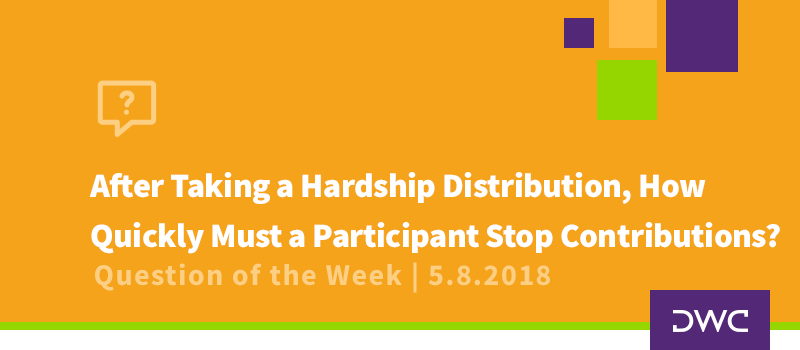
In Case of Emergency, (Don't) Break Plan!
It seems that with each major new retirement plan law, Congress has an idea that is great in concept but unnecessarily convoluted in implementation. It’s usually when they try to combine existing but previously separate features. With EGTRRA (in 2001), it was the sidecar IRA. With the Pension Protection Act (in 2006), it was the DB(k) plan. Now, as part of SECURE 2.0 (S2), it’s the so-called “pension-linked emergency savings account” or PLESA because acronyms.
We’re not sure whether it’s pronounced with a short E as in “plenty” or a long E as in “please”…we’ve heard it both ways.
The Great Idea
Countless surveys suggest many American families have little to nothing set aside for unexpected emergency-type expenses. So why not take advantage of an existing mechanism – the 401(k) plan –to allow participants to create a rainy day account within the plan?
Participants (limited to non-highly compensated employees) can make Roth contributions of up to $2,500 via payroll deduction to a PLESA, which must be invested in a vehicle specifically designed to preserve capital and earn a “reasonable rate of return.” Think money market, stable value, interest-bearing cash, etc. The plan must allow distributions from PLESAs at least monthly; however, a participant cannot be charged a distribution fee for his or her first 4 PLESA distributions in a year.
Sounds great, right?
The Unnecessarily Convoluted Implementation
Lest you think we are just being contrarian, there is a much more streamlined path to a pretty similar outcome. We’ll get to that in a minute, but first let’s look at some of the reasons you could break your plan by using PLESAs to help participants plan for emergencies.
Non-Highly Compensated Employees Only
PLESAs are only available to non-highly compensated employees (NHCEs). A participant who later becomes an HCE can continue to access his/her existing PLESA account but cannot make additional contributions for years during which s/he is an HCE.
This creates a couple of administrative wrinkles. One is the requirement to monitor the status (HCE or NHCE) of participants making PLESA contributions and notify them as well as update payroll to stop contributions when necessary. That’s more of an inconvenience than anything else.
The second is more wrinkly - use of the “top paid group” election to determine HCE status. Practically speaking, these plans can’t know who the HCEs are for a given year until sometime after the year begins, which certainly creates the environment for ineligible PLESA contributions despite everyone’s best efforts. Unfortunately, IRS Notice 2024-22 (the only IRS guidance we have to date) doesn’t address this.
Contribution Limit
PLESAs must be funded only from employee deferrals (i.e. not by company match or profit sharing) and must be made on a Roth basis. The 2025 contribution limit for PLESAs is $2,500 in aggregate, not per year, and is to be indexed for cost of living adjustments in future years.
Plan sponsors must track contributions vs. earnings for each participant to avoid exceeding this limit. It’s only when a participant takes a withdrawal that s/he can resume making PLESA contributions until again reaching that limit. Yep, that means sponsors must track that to know when to stop, re-start, re-stop, etc. the PLESA contributions via payroll. With that said, it is possible for plans to apply the $2,500 cap inclusive of investment gains to simplify administration.
Automatic Enrollment
PLESA contributions may be set up to require affirmative participant elections or automatic enrollment (with a default rate of no more than 3% of pay). PLESA auto enrollment provisions may not necessarily align with “regular” auto enrollment provisions, so companies would have to track and apply those rules separately. And while an affirmative deferral election with respect to a PLESA would also be treated as an affirmative election for other plan automatic enrollment provisions, automatically enrolling a participant in a PLESA does not satisfy the requirements of S2’s new auto enrollment mandate. Just typing that last sentence gives me a headache.
Coordination with Other Employee Contributions
A FAQ on the Department of Labor’s website makes clear that PLESA contributions count toward the regular employee deferral limit ($23,500 for 2025, as indexed, plus applicable catch-up contributions). They also confirm these contributions are subject to the same deposit deadline as any other deferrals.
Employer Matching Contributions
PLESA contributions must count the same as any other employee deferrals when calculating a company matching contribution. The match on PLESA contributions is also capped at $2,500 (though it’s made to a regular match account rather than to the PLESA account), which begs the question of how plans that match more than 100% can adhere to the limit. IRS guidance somewhat addresses this by allowing the match to first be determined with respect to non-PLESA deferrals, but that only helps when a participant is making both types of deferrals and the non-PLESA ones exceed the limits of the match formula.
Coordination with Safe Harbor 401(k) Provisions
This treatment of PLESAs for determining matching contributions could also put safe harbor match plans in unexpected (and probably unintended) jeopardy. The safe harbor rules state that no non-HCE can receive a rate of match that is any less than what any HCE receives.
Assume a plan provides a safe harbor match equal to 150% of the first 4% of pay each participant defers. Two participants (one HCE and the other not) each defer $2,000, but the non-HCE’s deferrals are to a PLESA. Both the safe harbor rules and the PLESA rules require equal treatment; however, that 150% match on PLESA contributions equals $3,000. If the sponsor caps the match at $2,500 to comply with the PLESA limit, that non-HCE is now receiving a rate of match that is less than what the HCE receives. We don’t yet have guidance to reconcile that.
Distributions
Plans that offer PLESAs must allow for at least monthly withdrawals and participants are not required to demonstrate any financial need as they would with a typical hardship withdrawal. These distributions are always considered to be Roth “qualified distributions” meaning that earnings are distributed tax free, and there is no early withdrawal penalty. As we mentioned earlier, participants cannot to be charged a fee for their first four withdrawals each year. That doesn’t mean there are no fees, only that those fees cannot be charged to the participant. So, either service providers must be willing to waive their fees for these transactions or plan sponsors will have to cover the costs.
Participant Notice
You probably guessed this already…there’s a new participant notice requirement. Participants must be provided a detailed notice 30 to 90 days before their first PLESA contributions are available and at least annually after that. We don’t yet have a model notice to use as a guideline, so good-faith compliance is the order of the day…it must be written in a manner that an average participant will understand. There are so many in the weeds details that’s it’s hard for us to keep up with them, and we do this everyday! How an “average” participant who has other things to do will understand it all is a bit of a head-scratcher.
An Easier Path to the Same Destination
With a recent Bankrate survey showing that 27% of adults in the U.S. have no emergency savings at all and that 43% would borrow money to cover an emergency expense of $1,000, it’s hard to argue there isn’t a need to more easily facilitate emergency savings. That brings us to that easier solution we promised you earlier.
Enter the good old fashioned after-tax contribution, which we discussed using for this very purpose way back in the Fall of 2020. There are no contribution limits other than the overall limit of $70,000 per year (for 2025, as indexed), and participants can access those accounts at any time. Contributions are included in the ACP test, so it would generally make sense to limit availability to non-HCEs, which is no different than the PLESA.
There are no special investment restrictions, no notice requirement, no mandate to match (but also no restrictions on matching), and participants can be charged the fees associated with taking distributions. The primary downside (if you can call it that) compared to the PLESA is that the earnings portion of any distribution is taxable. But given the circumstances, that’s not likely to be a significant amount.
We’re talking almost all of the benefits of the PLESA with almost none of the hassle.
What’s Next?
PLESAs were first available in 2024. The IRS Notice and DOL FAQ we mentioned earlier are the only guidance we’ve received so far other than the text of S2. Neither the sidecar-IRA nor the DB(k) gained much traction due to their undue complexity, and we can’t help wondering whether PLESAs will follow a similar pattern. After all, why would plan sponsors want to risk breaking their plans over participant emergencies when the after-tax contribution offers a solution that is much simpler by comparison.

















